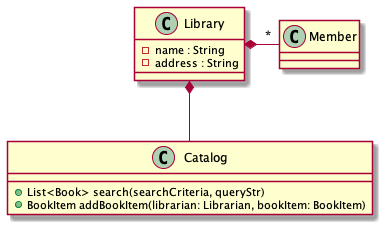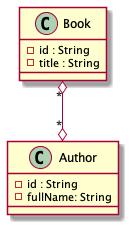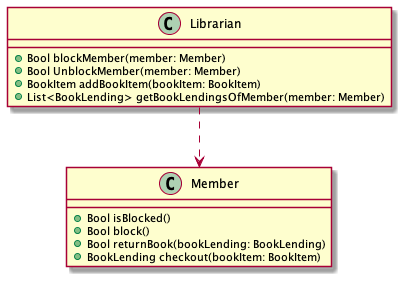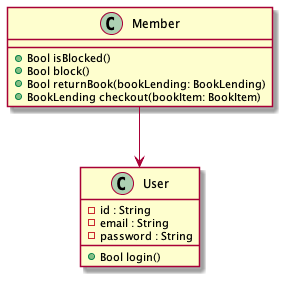This article is an excerpt from my book about Data-Oriented Programming.
More excerpts are available on my blog.
In the previous part, we presented a possible OO design for a library management system.
In this part, we continue our exploration of the tendency of OO systems to be complex.
Dave's reaction to your design
Dave follows you to your desk and you show him your piece of art: the UML diagram.
"Wow! Such a detailed class diagram." Dave is really excited.
"Yeah. It’s pretty neat." You reply proudly.
"The thing is that I can never remember the meaning of each arrow" Dave admits.
"There are 4 types of arrows in my class diagram: composition, association, inheritance and usage", you reply with a feeling of superiority.
"What’s the difference between composition and association?", Dave asks.
You google "composition vs association" and you read loudly to Dave:
"It’s all about whether the objects can live one without each other: with composition, when one object dies, the other one dies also, while in an association relation, each object has an independent life."
In my class diagram, there are two kinds of composition relation, symbolized by an arrow with a plain diamond at one edge, and an optional star at the other edge:
-
A
Libraryowns aCatalog. That’s a one-to-one composition relation: if aLibraryobject dies, then itsCatalogobject dies with it. -
A
Libraryowns manyMembers. That’s a one-to-many composition relation: if aLibraryobject dies, then all itsMemberobjects die with it.

"Do you have association relations in your diagram?" Dave asks
"Yeap. Take a look at the arrow between Book and Author.
It has an empty diamond and a start at both edges: it’s a many to many association relation".
Indeed, a book can be written by multiple authors
and an author can write multiplet books.
Moreover, Book and Author objects can live independently.

"I see also many dashed arrows in your diagram", Dave notices.
"Dashed arrows are for usage relations: when a class uses a method of another class.
Consider for example, at the Librarian::blockMember() method. It calls Member::block()."

"I see. And I guess that plain arrows - like the one between Member and User - represent inheritance."
"Absolutely"

"Great! Now that I understand the meaning of each kind of arrow. "Where should I look first?" Dave asks
"I think you should start from Library."

Library classIn terms of code, a Library object does nothing on its own, it delegates everything to objects it owns:
-
It owns multiple
Memberobjects -
It owns multiple
Librarianobjects -
It owns a single
Catalogobject
"Looks pretty clear to me. What’s next?"
"`Librarian` and Member who both derive from User "

Librarian and Member derive from UserThe User class represents a user of the library.
-
In terms of data members, I stick to the bare minimum: it has a
id,emailandpassword(I’ll deal with security and encryption, later). -
In terms of code, it can login via
login()
The Member class represents a member of the library.
-
It derives from
User -
In terms of data members, it has nothing more than
User -
In terms of code, it can:
-
Checkout a book via
checkout() -
Return a book via
returnBook() -
Answer if it is blocked via
isBlocked()
-
-
It owns multiple
BookLendingobjects -
It uses
BookItemin order to implementcheckout()
The Librarian class represents a librarian.
-
It derives from
User -
In terms of data members, it has nothing more than
User -
In terms of code, it can:
-
Block and unblock a
Member -
List the book lendings of a member via
getBookLendings() -
Add book items to the library via
addBookItem()
-
-
It uses
Memberin order to implementblockMember(),UnblockMember()andgetBookLendings() -
It uses
BookItemin order to implementcheckout() -
It uses
BookLendingin order to implementgetBookLendings()
"What class should I look at now?"
"The Catalog class who is responsible for the management of the books."

Catalog classCatalog object can:-
Search books via
search() -
Add book items to the library via
addBookItem()-
It owns multiple
Bookobjects -
It uses
Librarianin order to implementaddBookItem
-
"Then we have the Book class"

Book class-
In terms data members, we stick to the bare minimum: it has a
id, and atitle -
It is associated with multiple
Authorobjects (A book might have multiple authors) -
It owns multiple
BookItemobjects, one for each copy of the book
"What’s a BookItem?"
"The BookItem class represents a book copy. A book could have many copies."
-
In terms data members, we stick to the bare minimum: it has a
id, and arackId(for its physical location in the library) -
In terms of code, it can be checked out via
checkout() -
It owns multiple
BookLendingobjects, one for each time the book is lent
"Wow! That’s amazing" Dave compliments you. "I didn’t know people were really spending time to write down their design in such details, before coding."
"I always do that. It saves me lots of coding errors", you reply proudly.
"When will you start coding?" Dave asks
"When I finish my coffee".
You look at your coffee mug and it’s full (and cold). You were so excited to show your class diagram to Dave that you forgot to drink your coffee.
Go and make yourself another cup of coffee before you move to the next part.
